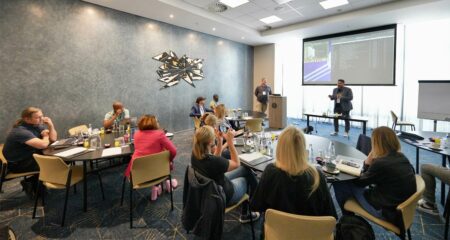 Edge computing isn’t nearly as adventurous as it sounds, and it is not an adrenaline sport. However, it does offer businesses several advantages in that it brings data, and the speed of accessing that data, much closer to the company, giving it greater insight.
Edge computing isn’t nearly as adventurous as it sounds, and it is not an adrenaline sport. However, it does offer businesses several advantages in that it brings data, and the speed of accessing that data, much closer to the company, giving it greater insight.
The sheer volume of data coming in to organisations is something all companies are battling to get to grips with. A year ago, SUSE indicated that on average people swipe, click or tap our mobile phones 2 617 times a day.
Cisco has predicted that we are going to be creating 930 exabytes of data by 2022, which will be about 20% of all the Internet traffic in that year. There is an explosion of data points, data collection points, data origins and areas where data comes in to be consumed by the business.
A recent SUSE and TechCentral webinar unpacked the big issues around edge computing. Click play on the video below to watch the full webinar now.
In the webinar, Christophe le Dorze, SUSE ISV technical architect, said the explosion of data and data points, like those used for Internet of things (IoT), has generated new challenges for solutions based on cloud computing technology, because these applications usually require reduced latency response in real time. Edge computing has emerged as a solution to this problem, he said.
“Edge” essentially pre-processes data collected by devices to optimise computing and storage processes prior to sending them into the cloud.
Matthew Lee, SUSE’s cloud and strategic alliances manager for Africa, explains that edge computing, as a business enabler, cuts across the areas of speed and insight. Edge, he said, brings those applications closer to the data.
This, said Lee, is “a new frontier, where distributed IT infrastructure can be deployed much closer to the action”. As a result, edge gives business the ability to increase the speed at which it gets insights, with less bandwidth, as it strips out the requirement to send that data to the data centres.
Edge computing is a distributed, open IT architecture that features decentralised processing power, which enables mobile computing and IoT technologies. It allows for data to be processed by the device or a local computer or server, instead of being sent to a data centre.
Journey
However, said Lee, edge does not replace an IT strategy, but rather augments it. It allows for improved operational efficiency and performance and can even automate some processes that were manual.
“Don’t make the mistakes of the past and try and merely change the destination of your compute core, but rather look to bring all those aspects of your infrastructure into one platform, from the edge, to the core, to the cloud and beyond.”
Lee adds that most companies are on a journey towards edge computing. An example of a real-life use of edge computing would be if a transport company in South Africa placed sensors on all its moveable devices from cranes to conveyor belts, which would allow the company to monitor its equipment for wear and tear, breakdowns, and so on.

This will give the company insights that will allow them to take preventative maintenance measures, thus reducing downtime and increasing profits. “It’s the power of insights.”
Preparation for this sort of capability, which sounds very futuristic, is already happening, and consumers can see it in their daily lives as well, in areas such as sensors that warn drivers of a flat tyre.
What Le Dorze is seeing happen is a blend of more agile technologies being used with existing infrastructure as edge becomes more mainstream.
In sub-Saharan Africa, industries that are already embracing edge computing include manufacturing, retail, and financial services. Lee said these three big areas are adopting edge computing because they have the most to lose if they don’t make this change to their business.
In Europe, said Le Dorze, every type of ground transportation is moving to the edge, from trains to cars. In some areas, this also includes aerospace.
While this is the main industry embracing edge, that doesn’t mean that others such as healthcare are being ignored.
Smart cities
There is also a role for edge to play when it comes to starting to move to smart cities, such as knowing when pipes have burst or valves broken, said Lee. “All of those aspects are key to delivering an effective service to a citizen.”
By definition, explains Le Dorze, smart cities are ones in which services and functions are smartly operated through the insights gleaned from data. An example of smart technology is an access card that works to open doors, and to order food in a cafeteria. Another example is being able to unlock doors and turn lights on through a mobile phone.
Lee adds that smart cities are really meant to improve operational efficiency and provide better quality of service to citizens. Smart cities are about using the information that the city has to provide better quality of governance and service to the citizens for their improved welfare.
However, that doesn’t mean that companies should do too much and try to put sensors on everything, said Lee. “You have to keep it small, cheap and easy to replicate. Companies that put too much processing on edge devices soon find that the latency and speed issues that they were looking to solve with their edge computing strategy actually come back in a new form — and sometimes even make things worse.”
Edge, said Lee, is there to augment an environment; it’s not there to replace it. Companies should have a cloud strategy, an IoT strategy and an edge strategy, and use enterprise architecture to bring it together.
Security
In addition, security needs to be a key part of any architecture to ensure that companies reduce their vulnerability to cyber threats. It cannot be an afterthought, said Lee.
“The more you interact with humans, the more you have to prove to authorities how secure and safe your systems are, and both aspects are different. Security is about protecting the data, while safety is about protecting lives,” said Le Dorze.
At the same time, said Lee, one aspect that cannot be forgotten is the people factor.
- This promoted content was paid for by the party concerned




